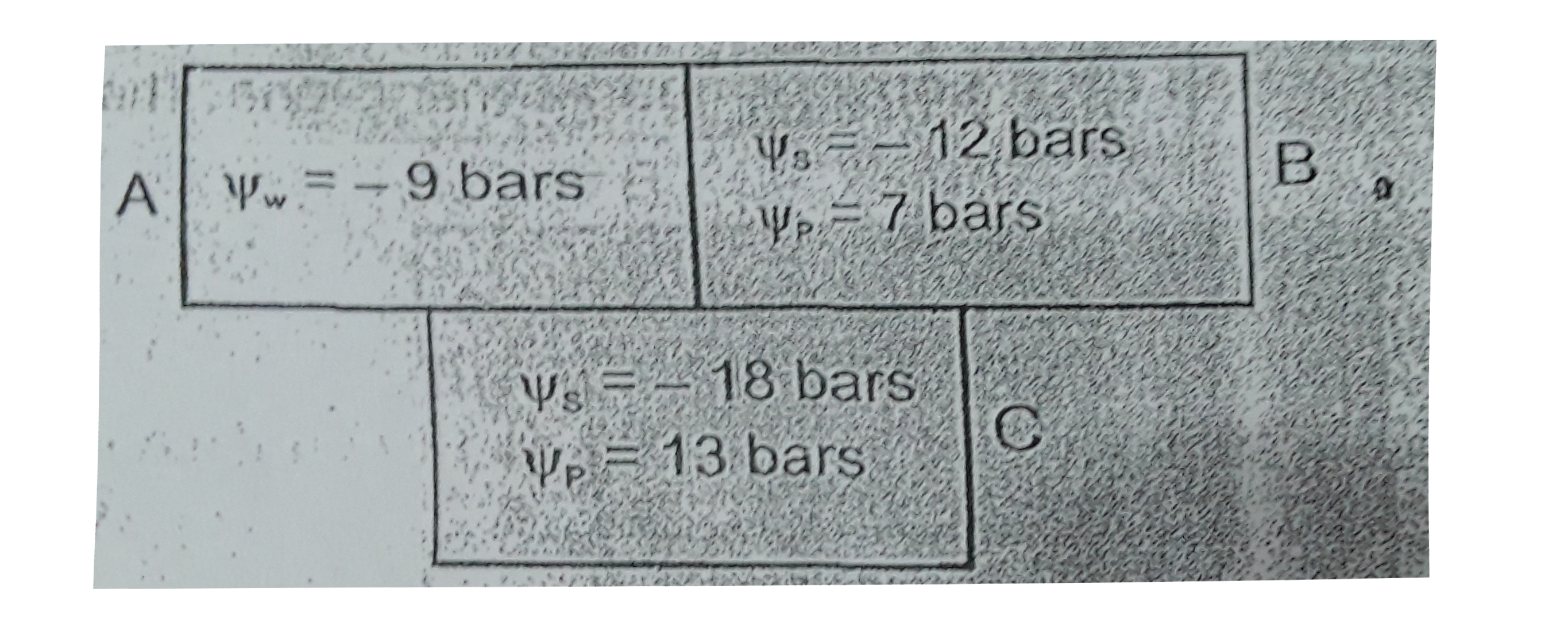What do the terms ΨsandΨp denotes?
To answer the question regarding the terms Ψs and Ψp, we can break it down into the following steps:
1. Understanding the Symbols:
- The symbols Ψs and Ψp are commonly used in plant physiology to represent specific components of water potential.
2. Definition of Psi_(s):
- Ψs denotes the solute potential (also known as osmotic potential). It refers to the potential of water to move due to the presence of solutes.
- In general, solute potential is negative because the addition of solutes to water reduces its potential energy, making it less likely for water to move into the cell.
3. Function of Psi_(s):
- The solute potential influences the movement of water into and out of cells. A higher concentration of solutes in a solution will lead to a lower (more negative) solute potential, which prevents water from entering the cell and can cause the cell to lose water.
4. Definition of Psi_(p):
- Ψp denotes the pressure potential. This is the physical pressure exerted by the fluid (water) within the cell against the cell wall.
- Pressure potential can be positive or zero. When a plant cell is turgid (full of water), the pressure potential is positive, which helps maintain the cell's structure.
5. Function of Psi_(p):
- The pressure potential works in opposition to the solute potential. It helps to move water into the cell, preventing it from shrinking and promoting cell turgidity. This is crucial for maintaining the structural integrity of plant tissues.
6. Relationship Between Psi_(s) and Psi_(p):
- Both Ψs and Ψp together contribute to the overall water potential (Ψ), which determines the direction of water movement in plants. The equation can be summarized as:
\(
\Psi = \Psi_(s) + \Psi_(p)
\)
- A more negative water potential indicates a stronger tendency for water to move into a cell, while a positive pressure potential indicates that the cell is turgid and can hold more water.
Summary:
- Ψs = Solute potential (negative value).
- Ψp = Pressure potential (positive value).
- The symbols Ψs and Ψp are commonly used in plant physiology to represent specific components of water potential.
- Ψs denotes the solute potential (also known as osmotic potential). It refers to the potential of water to move due to the presence of solutes.
- In general, solute potential is negative because the addition of solutes to water reduces its potential energy, making it less likely for water to move into the cell.
- The solute potential influences the movement of water into and out of cells. A higher concentration of solutes in a solution will lead to a lower (more negative) solute potential, which prevents water from entering the cell and can cause the cell to lose water.
- Ψp denotes the pressure potential. This is the physical pressure exerted by the fluid (water) within the cell against the cell wall.
- Pressure potential can be positive or zero. When a plant cell is turgid (full of water), the pressure potential is positive, which helps maintain the cell's structure.
- The pressure potential works in opposition to the solute potential. It helps to move water into the cell, preventing it from shrinking and promoting cell turgidity. This is crucial for maintaining the structural integrity of plant tissues.
- Both Ψs and Ψp together contribute to the overall water potential (Ψ), which determines the direction of water movement in plants. The equation can be summarized as:
\(
\Psi = \Psi_(s) + \Psi_(p)
\)
- A more negative water potential indicates a stronger tendency for water to move into a cell, while a positive pressure potential indicates that the cell is turgid and can hold more water.
- Ψs = Solute potential (negative value).
- Ψp = Pressure potential (positive value).
Topper's Solved these Questions
- TRANSPORT IN PLANTSBOOK - MODERN PUBLICATIONCHAPTER - TRANSPORT IN PLANTSEXERCISE - REVISION EXERCISES (SHORT ANSWER QUESTIONS)
36 Videos
- TRANSPORT IN PLANTSBOOK - MODERN PUBLICATIONCHAPTER - TRANSPORT IN PLANTSEXERCISE - REVISION EXERCISES (LONG ANSWER QUESTIONS)
10 Videos
- TRANSPORT IN PLANTSBOOK - MODERN PUBLICATIONCHAPTER - TRANSPORT IN PLANTSEXERCISE - QUICK MEMORY TEST(CHOOSE THE CORRECT ALTERNATIVE)
6 Videos
- THE LIVING WORLDBOOK - MODERN PUBLICATIONCHAPTER - THE LIVING WORLDEXERCISE - Chapter Practice Test
16 Videos
Similar Questions
Knowledge Check
Soluton A has Ψs =-30 bars and Ψp = 5 bars. Solution B has Ψs = -10 bars and Ψp = 0 atm. The two are separated by semipermeable membrane . Flow of water will be
AB to ABA to BCEqual in both directionsDNo flow of water .Consider the following
i. For a solution at atmospheric pressure Ψw=Ψs
ii. Ψw (water potential) of a cell is affected by solute potential only
iii. Ψp (pressure potential ) is usually positive in xylem during the day which of the statements given above is/are correct?Aii & iiiBI onlyCii onlyDI, ii and iiiAn A.P. and a G.P. with positive terms have the same number of terms and their first terms as well as last terms are equal. Then what can be said about the sum of the A.P. and G.P. If As and Gs denote the sum of the A.P. and G.P. respectively :
AAs≥GsBAs≤GsCAs=GsDcan't be determined
(a) Deduce the vaule of ΨW if OP and ΨP are 10 and 7 bars respectively .
(b) Give the direction for the flow of water in the given diagram

View SolutionCell A and cell B are adjacent plant cells. In cell A Ψs=−20 bars and Ψp=8 bars. In cell B, Ψs=−12 bars and Ψp=2 bars . Then,
View SolutionWhat would be the ΨP of a flaccid cell ?
View SolutionWhatdoos the letter 'P' denote in the term 'PAN' as used in financial transactions ?
View SolutionIf in a G.P. of 3n terms S1,S2,S3 denote the sum of first n, sum of middle n terms and sum of last n terms respectively, then S1,S2,S3 are in
View Solution
